Workplace fire safety is a critical aspect that cannot be overlooked. Understanding the common causes of workplace fires and their potential impact is essential for creating a safe environment for employees, visitors, and property.
Workplace fires can have devastating consequences, ranging from injuries and fatalities to property damage and business disruptions. They can lead to significant financial losses and tarnish a company's reputation.
By recognizing the potential risks and hazards that may lead to fires, employers can take proactive steps to mitigate these dangers and enhance fire safety protocols.
Through this guide, we aim to increase awareness about the common causes of workplace fires and equip businesses and organizations with knowledge to prevent accidents at the workplace.
Join us as we dive into the world of workplace fire safety and learn how to protect your workforce and assets from the devastating impact of fires.
Implementing effective fire prevention measures and fostering a safety-conscious culture can make a significant difference in reducing the occurrence of workplace fires and ensuring the well-being of everyone within the premises.
Top 10 Common Causes Of Workplace Fires
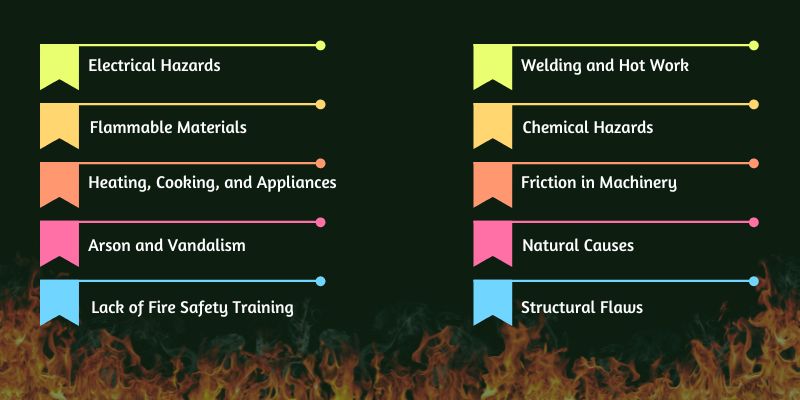
Workplace fires can have catastrophic consequences, jeopardizing the safety of employees and causing significant property damage. The top five common causes of workplace fires include the following:
-
Electrical hazards
-
Flammable materials
-
Heating, cooking, and appliances
-
Arson and vandalism
-
Lack of fire safety training
-
Welding and hot work
-
Chemical hazards
-
Friction or overheating in machinery
-
Natural causes
-
Structural flaws
Understanding these causes is crucial for employers to implement effective fire prevention strategies and ensure a safe working environment for their workforce.
By addressing these potential fire risks, businesses can minimize the occurrence of workplace fires and protect their employees and assets.
1. Electrical Hazards
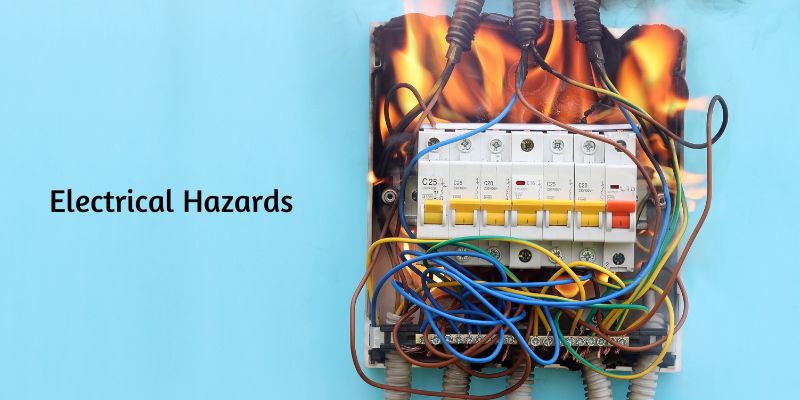
Electrical hazards are one of the primary causes of workplace fires, posing significant risks to safety and property.
These hazards can originate from various sources, including faulty wiring, overloaded circuits, and malfunctioning electrical equipment.
Understanding the causes and implementing preventive measures is crucial to mitigating the risks associated with electrical hazards.
The Fire Hazard
Faulty Wiring and Outdated Systems: Old, poorly installed, or outdated electrical systems can lead to short circuits, overheating, and electrical arcing. These conditions can ignite nearby combustible materials, leading to fires.
Overloaded Circuits: Plugging too many devices into a single circuit can cause it to overload. Overloaded circuits can overheat and potentially cause wires to melt, sparking fires. This is particularly common in workplaces with a high demand for electrical power.
Defective Electrical Equipment: Malfunctioning electrical devices and appliances can generate heat and sparks. For example, a faulty coffee machine or space heater can quickly become a fire hazard if it fails and ignites nearby materials.
Improper Use of Extension Cords: Extension cords, if not used correctly, can pose significant fire risks. Overloading extension cords, using them as permanent wiring solutions, or running them under carpets or through doorways can lead to overheating and fires.
Lack of Maintenance: Regular maintenance ensures that electrical systems and equipment remain safe. Neglecting maintenance can lead to the deterioration of insulation, connections, and components, increasing the likelihood of electrical fires.
Key Risk Factors
High Electrical Load: Workplaces with high electrical demands, such as factories and offices with extensive computer networks, are at greater risk of overloading circuits and experiencing electrical faults.
Environmental Factors: Dust, moisture, and corrosive environments can deteriorate electrical components, making them more susceptible to short circuits and other failures that can ignite fires.
Human Error: Improper use of electrical equipment, such as using inappropriate extension cords or failing to turn off devices when not in use, can significantly increase fire risks.
Preventive Measures
Regular inspections of electrical systems and equipment can identify potential issues before they lead to fires. Qualified electricians should perform these inspections to ensure compliance with safety standards.
Upgrading Electrical Systems: Ensuring that electrical systems are modern and meet current safety codes can reduce the risk of fires. Upgrading old wiring, installing circuit breakers, and using ground fault circuit interrupters (GFCIs) are essential.
Proper Use of Electrical Equipment: Educating employees on correctly using electrical equipment and extension cords can prevent common misuse that leads to fires. Emphasize the importance of not overloading circuits and turning off equipment when not in use.
Maintenance and Repairs: Implementing a regular maintenance schedule for all electrical equipment and systems is crucial. This includes checking for frayed wires, loose connections, and other signs of wear and tear.
Emergency Preparedness: Ensure that fire extinguishers and other emergency equipment are readily available and that employees are trained. Regular fire drills and emergency response training can enhance workplace safety.
Safe Storage of Combustibles: Keep flammable materials away from electrical equipment and outlets. Proper storage and handling of combustible materials can prevent them from igniting if an electrical fault occurs.
By recognizing and addressing electrical hazards, workplaces can significantly reduce the risk of fires. Additionally, employees should be trained to recognize potential electrical and hidden workplace hazards and report them immediately to mitigate risks.
2. Flammable Materials
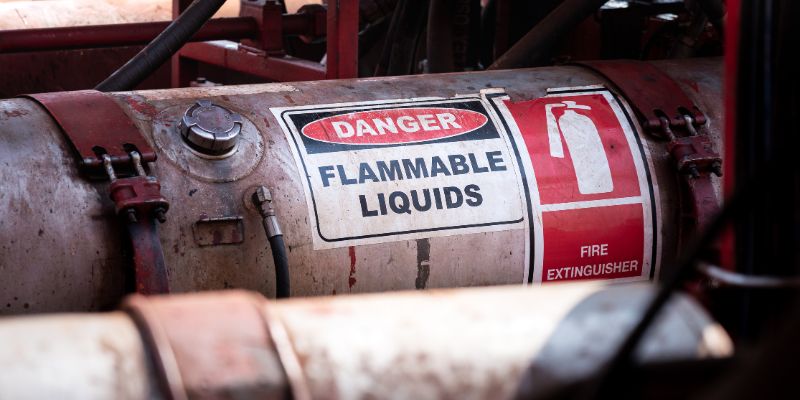
Flammable materials are a significant cause of workplace fires, posing substantial risks due to their ability to ignite easily and burn rapidly.
These materials include various substances in various industries, such as chemicals, gases, liquids, and solids.
Proper handling, storage, and disposal of flammable materials are crucial to preventing fires and ensuring workplace safety.
The Fire Hazard
Chemicals: Many workplaces use highly flammable chemicals, such as solvents, fuels, and cleaning agents. These substances can ignite if exposed to sparks, open flames, or high temperatures, leading to rapid and intense fires.
Gases: Flammable gases, like propane, methane, and acetylene, are used in numerous industrial processes. These gases can form explosive mixtures with air and are extremely dangerous if not adequately controlled and contained.
In certain industries, toxic gases like hydrogen sulphide (H₂S) may also be present. Workers should undergo H2S training to recognize exposure risks, use detection equipment, and follow safe handling protocols alongside fire safety measures.
Liquids: Flammable liquids, such as gasoline, alcohol, and certain oils, can quickly vaporize and form explosive mixtures with air. Even small spills of these liquids can create significant fire hazards, especially in poorly ventilated areas.
Solids: Materials like paper, wood, and textiles can catch fire if exposed to heat sources or sparks. In particular, dust from these materials can form explosive clouds when suspended in the air, posing additional fire risks.
Key Risk Factors
Improper Storage: Storing flammable materials improperly, such as near heat sources, in non-ventilated areas, or inappropriate containers increases the likelihood of ignition.
Inadequate Handling Procedures: Mishandling flammable materials, such as spilling liquids, generating sparks near flammable gases, or allowing chemical vapors to accumulate, can lead to fires.
Insufficient Training: Employees must be adequately trained in safely handling and storing flammable materials, which may inadvertently create fire hazards through improper practices.
Preventive Measures
Proper Storage: Store flammable materials in designated areas away from heat sources and direct sunlight. Use appropriate containers that are clearly labeled and meet safety standards for flammable materials.
Handling Procedures: Develop and implement strict handling procedures for flammable materials. This includes using appropriate equipment to transfer liquids, grounding and bonding containers to prevent static sparks, and using non-sparking tools.
Regular Inspections: Regularly inspect storage areas, containers, and handling procedures to ensure compliance with safety standards. Look for signs of leaks, corrosion, or other potential hazards.
Employee Training: Provide comprehensive training on the dangers of flammable materials and the proper handling, storage, and disposal procedures. Ensure that employees understand the importance of following safety protocols.
Emergency Preparedness: Equip work areas with appropriate fire suppression systems, such as fire extinguishers, sprinklers, and fire blankets. Conduct regular fire drills and ensure that all employees know the emergency procedures in case of a fire.
Safe Disposal: Dispose of flammable waste materials according to regulatory guidelines. Do not allow flammable waste to accumulate in the workplace; use designated disposal containers.
Regular maintenance, proper usage, and diligent monitoring of these appliances are essential to prevent workplace fires.
Additionally, establishing clear guidelines and enforcing fire safety practices for operating such equipment can contribute to fire prevention efforts.
Furthermore, conducting accident incident investigation training can help companies and employees understand the reasons for accidents, and they will be better prepared in the future.
3. Heating, Cooking, and Appliances
Heating equipment, cooking appliances, and electrical devices are standard features in many workplaces, but they also present significant fire hazards if not used and maintained correctly.
Understanding the risks associated with these elements is essential for preventing workplace fires and ensuring the safety of employees.
Common Hazards
Heating Equipment: Furnaces, space heaters, and boilers can pose fire hazards if they malfunction, overheat, or come into contact with flammable materials. Poor maintenance, improper installation, or use of damaged equipment can increase fire risk.
Cooking Appliances: Kitchens, break rooms, and cafeterias often contain cooking appliances like stoves, ovens, microwaves, and toasters. If left unattended or misused, these appliances can cause fires due to overheating, grease buildup, or electrical malfunctions.
Electrical Devices: Computers, printers, copiers, and other electrical devices are standard in modern workplaces. If not addressed promptly, overloaded circuits, damaged wiring, and faulty equipment can lead to electrical fires. Additionally, using extension cords and power strips can increase the risk of electrical hazards if not used correctly.
Key Risk Factors
Improper Use: Employees may misuse heating equipment or cooking appliances by placing flammable materials too close to heat sources, leaving cooking unattended, or using damaged electrical devices. Lack of proper training and awareness contributes to these hazards.
Lack of Maintenance: Failure to perform regular maintenance on heating equipment, cooking appliances, and electrical devices can lead to malfunctions, overheating, and electrical fires. Neglected equipment is more prone to breakdowns and poses a greater risk to workplace safety.
Overloading Circuits: Plugging too many electrical devices into a single outlet or circuit can overload the system, leading to overheating and electrical fires. This often occurs when employees misuse extension cords and power strips.
Preventive Measures
Regular Inspections: Conduct routine inspections of heating equipment, cooking appliances, and electrical devices to ensure they are in good working condition. Look for signs of damage, wear and tear, and malfunctioning components.
Maintenance Schedule: Establish a schedule for all workplace heating, cooking, and electrical equipment. Regularly clean, repair, and service these devices to prevent breakdowns and reduce fire risks.
Employee Training: Provide comprehensive fire extinguisher training on safely using and maintaining heating equipment, cooking appliances, and electrical devices. Emphasize the importance of following manufacturer instructions and safety guidelines.
Fire Safety Protocols: Develop and communicate fire safety protocols that address using heating, cooking, and electrical equipment in the workplace. Educate employees on evacuation procedures, fire extinguisher use, and emergency response.
Regular maintenance, employee training, and adherence to safety protocols are essential components of a comprehensive fire prevention strategy.
4. Arson and Vandalism
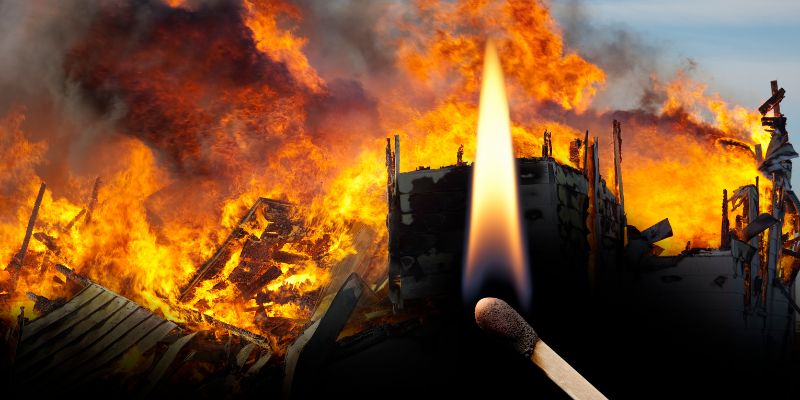
Arson and vandalism are deliberate acts of destruction that can result in devastating workplace fires.
While less common than accidental fires, intentional fires pose significant risks to the safety of employees, businesses' stability, and properties' integrity.
Understanding the motivations behind arson and vandalism and implementing preventive measures are crucial for safeguarding workplaces against these threats.
Motivations for Arson and Vandalism
Financial Gain: Perpetrators may set fire to workplaces with the intent of committing insurance fraud or obtaining financial compensation. Destroying property through arson can result in substantial payouts from insurance companies, making it an attractive option for individuals seeking monetary gain.
Revenge or Retaliation: Disgruntled employees, former employees, or individuals with personal vendettas against a company or its leadership may resort to arson or vandalism as revenge or retaliation. Feelings of anger, resentment, or perceived injustice often drive these acts.
Criminal Intent: Criminal organizations or individuals involved in illicit activities may target workplaces for arson or vandalism as part of broader criminal schemes. These acts may be intended to cover up other illegal activities, disrupt business operations, or exert control over territories or markets.
Political or Ideological Motivations: Extremist groups, activists, or individuals with radical ideologies may act arson or vandalism to advance their political or ideological agendas. These incidents are often intended to send a message, instill fear, or protest perceived injustices.
Preventive Measures
Security Measures: Implement comprehensive security measures, including surveillance cameras, alarm systems, access controls, and perimeter fencing, to deter potential arsonists and vandals. Visible security measures can act as a deterrent and increase the likelihood of detection and apprehension.
Employee Awareness: Educate employees about the risks of arson and vandalism and encourage them to report any suspicious activities or individuals to management or security personnel. Establish clear reporting procedures and mechanisms for employees to raise concerns confidentially.
Community Engagement: To enhance surveillance and response capabilities and foster positive relationships with the local community and law enforcement agencies. Collaborate with community organizations, neighborhood watch groups, and business associations to promote vigilance and share information about potential threats.
Property Protection: Secure valuable assets, equipment, and sensitive information to minimize the potential impact of arson or vandalism. Store flammable materials, hazardous substances, and combustible waste in designated areas with restricted access and proper containment measures.
Collaboration between employers, employees, law enforcement agencies, and community stakeholders is essential for effectively preventing and responding to these threats.
5. Lack of Fire Safety Training
Insufficient fire safety training is among the primary causes of workplace fires, contributing to an increased risk of ignition, ineffective emergency response, and inadequate fire prevention measures.
Without proper training, employees may lack the knowledge and skills to identify fire hazards, respond appropriately to early warning signs, and implement preventive measures, placing themselves and others at greater risk of harm.
Key Factors Contributing to Lack of Fire Safety Training
Employee Ignorance: With adequate education and training, they may recognize fire hazards, such as improperly stored flammable materials or overloaded electrical circuits, and inadvertently engage in behaviors that increase the likelihood of ignition.
Employer Negligence: Inadequate training budgets, competing priorities, and a lack of awareness about regulatory requirements may result in minimal or superficial fire safety training initiatives, leaving employees ill-prepared to prevent, detect, and respond to fires effectively.
High Turnover Rates: Industries with high turnover rates, such as retail, hospitality, and seasonal employment sectors, may need help maintaining consistent fire safety training standards across their workforce. Frequent staff turnover can hinder the effectiveness of training efforts.
Language and Cultural Barriers: Inadequate translation services, cultural insensitivity, and communication barriers may impede employees' understanding of fire safety concepts and hinder their ability to follow emergency procedures during a crisis.
Mitigating the Risk through Comprehensive Training
Fire Safety Awareness: Provide comprehensive fire safety training to all employees, emphasizing the importance of fire prevention, hazard identification, emergency response protocols, and evacuation procedures.
Hands-On Exercises: Incorporate practical hands-on exercises, such as fire extinguisher drills that teach how to use a fire extinguisher, along with evacuation simulations and emergency response scenarios, to reinforce learning and develop practical skills.
Regular Refresher Training: Conduct regular refresher training sessions to reinforce key fire safety concepts, update employees on changes to policies or procedures, and address any emerging fire hazards or concerns in the workplace.
Multilingual and Culturally Sensitive Training: Provide fire safety training materials and resources in multiple languages to accommodate employees' diverse linguistic backgrounds and cultural preferences.
By prioritizing comprehensive fire safety training initiatives and addressing the underlying factors contributing to a lack of training, employers can empower their workforce to identify and mitigate fire hazards and effectively reduce the incidence of workplace fires.
6. Welding and Hot Work

Welding and hot work are significant in many industries, including construction, manufacturing, and repair.
They are also one of the leading causes of workplace fires due to the inherent risks associated with high temperatures, open flames, and the potential for sparks.
Understanding the risks and implementing stringent safety measures is crucial to prevent fires caused by welding and hot work.
The Risks of Welding and Hot Work
High Temperatures and Open Flames: Welding and hot work involve torches, welding machines, and other equipment that produce high temperatures and open flames. These can easily ignite combustible materials nearby.
Sparks and Molten Metal: The welding process generates sparks and molten metal droplets, which can travel considerable distances and ignite flammable materials. Even seemingly non-flammable materials can catch fire if they accumulate heat or the sparks find a small, combustible surface to ignite.
Proximity to Flammable Materials: Work areas where welding and hot work are performed often contain flammable materials such as paper, wood, textiles, and flammable liquids. These materials can quickly catch fire if not properly cleared or shielded.
Faulty Equipment: Equipment used in welding and hot work must be appropriately maintained. Faulty or poorly maintained equipment can cause sparks, electrical shorts, and other hazards that lead to fires.
Preventive Measures
Designated Work Areas: Conduct welding and hot work in designated areas specifically designed to handle such activities. These areas should be free from flammable materials and equipped with appropriate fire suppression systems.
Fire Watch: Implement a fire watch program where a trained individual monitors the work area during and after welding or hot work to detect and extinguish any sparks or fires immediately.
Use of Fire-Resistant Barriers: Employ fire-resistant barriers and blankets to shield flammable materials from sparks and heat generated during welding and hot work.
Inspection and Maintenance of Equipment: Regularly inspect and maintain welding and hot work equipment to ensure it works properly. This includes checking for damaged cables, faulty connections, and other potential hazards.
Training and Awareness: Provide comprehensive training to employees on the risks associated with welding and hot work and the necessary precautions to prevent fires. Training should include proper equipment use, identification of flammable materials, and emergency response procedures.
Transparent Workspaces: Before beginning welding or hot work, ensure the work area is clear of flammable materials. This includes removing combustible materials, sweeping the floor to clear debris, and covering any remaining flammable items with fire-resistant covers.
Proper planning, vigilance, and adherence to safety protocols are essential to maintaining a safe work environment and protecting employees from fire hazards.
7. Chemical Hazards
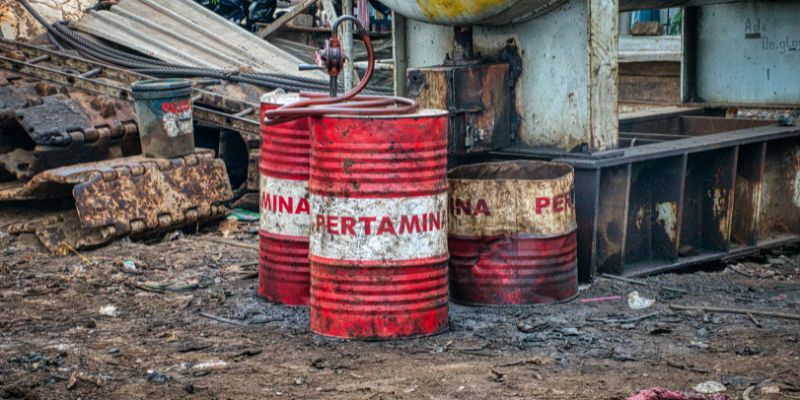
Chemical hazards significantly cause workplace fires, given the wide range of flammable and reactive substances commonly used in various industries.
If not adequately managed, chemicals can ignite under specific conditions, leading to fires and explosions.
The Fire Hazard
Many chemicals are highly flammable or even explosive under the right conditions.
These substances can be gases, liquids, or solids, and their potential to cause fire depends on factors such as volatility, reactivity, and ignition sources.
Common examples include solvents, fuels, gases, and combustible dust.
Key Risk Factors
Flammable Liquids and Gases: Many industrial processes use flammable liquids like gasoline, acetone, and alcohol or gases like propane and hydrogen. These substances can quickly vaporize and ignite in the presence of a spark or open flame.
Combustible Dust: Dust from wood, flour, sugar, and certain metals can form explosive mixtures when dispersed in the air. A single spark or static discharge can ignite these dust clouds, causing devastating fires or explosions.
Chemical Reactions: Some chemicals can react violently when mixed with incompatible substances, generating heat and potentially leading to fires. For example, mixing acids with bases or certain chemicals with water can produce exothermic reactions.
Improper Storage: Chemicals stored improperly, such as close to ignition sources or incompatible substances, increase the risk of fire. Flammable materials must be stored in appropriate containers and environments to prevent accidental ignition.
Preventive Measures
Proper Labeling and Storage: Correctly labeling and storing chemicals according to their hazard classifications can prevent accidental mixing and reduce fire risks. Flammable liquids and gases should be kept in designated, well-ventilated areas away from ignition sources.
Regular Inspections and Maintenance: Regular inspections of chemical storage areas and equipment can help identify potential fire hazards. Proper maintenance of containers and handling equipment is essential to prevent leaks and spills.
Safety Data Sheets (SDS): Keeping and maintaining SDS for all hazardous chemicals provides essential information on fire hazards, handling precautions, and emergency measures, helping to mitigate risks.
Proper handling, storage, and training are crucial components in preventing chemical-related fires.
Friction or Overheating in Machinery
Friction or overheating in machinery is a common cause of workplace fires, especially in industrial settings where heavy machinery and equipment are used regularly.
When machinery components rub against each other without proper lubrication or when equipment operates under excessive load, it can generate significant heat.
If this heat is not managed, it can ignite nearby combustible materials, leading to fires.
The Fire Hazard
Heat Generation: Friction between moving parts in machinery generates heat. If components are not properly lubricated, this heat can increase to dangerous levels. Additionally, overworked or poorly maintained equipment can overheat, exacerbating the risk.
Sparks: Friction can also produce sparks, particularly in metal-on-metal contact situations. These sparks can easily ignite flammable materials or vapors in the vicinity, leading to fires.
Overheating: It can overheat when machinery operates beyond its intended capacity or for extended periods without adequate cooling. Overheated machinery can ignite dust, oils, or other flammable substances present on or near the equipment.
Key Risk Factors
Lack of Maintenance: Regular maintenance is crucial for ensuring machinery operates smoothly. Neglecting maintenance can lead to increased friction and overheating, as worn-out parts and old lubricants fail to reduce heat generation effectively.
Improper Lubrication: Machinery requires proper lubrication to minimize friction between moving parts. Using the wrong type or insufficient lubricant can increase friction and heat.
Overloaded Machinery: Operating machinery beyond its designed capacity stresses the components, causing them to overheat. This is particularly common in industries where maximizing productivity is prioritized over equipment safety.
Preventive Measures
Regular Maintenance and Inspections: A routine maintenance schedule ensures that machinery is in good working condition. Regular inspections can identify worn-out parts, insufficient lubrication, and other issues that could lead to overheating.
Proper Lubrication: Ensuring that all moving parts are adequately lubricated with the correct type of lubricant can significantly reduce friction and heat generation. Following the manufacturer's recommendations for lubrication intervals and types is essential.
Temperature Monitoring: Installing temperature sensors on machinery can provide real-time monitoring of heat levels. This allows for early detection of overheating and timely intervention before a fire starts.
By addressing the risks associated with friction and overheating in machinery, workplaces can prevent fires and enhance overall safety. Regular maintenance, proper lubrication, and effective temperature management are crucial to mitigating these fire hazards.
Natural Causes
Though less frequent than human-related incidents, natural causes can still significantly contribute to workplace fires.
These causes are often unpredictable and can result in extensive damage if proper precautions are not taken.
Understanding and preparing for these natural fire hazards is crucial for workplace safety.
The Fire Hazard
Lightning Strikes: Lightning is one of the most common natural causes of fires. It can strike buildings, outdoor storage areas, or flammable materials, igniting them and leading to fires. This risk is exceptionally high in areas prone to thunderstorms.
Wildfires: Businesses located near forests or grasslands are at risk in regions susceptible to wildfires. Wildfires can spread rapidly, engulfing buildings and industrial sites. Factors such as dry weather, high winds, and dense vegetation can exacerbate the spread of wildfires.
Earthquakes can indirectly cause fires by damaging electrical systems, gas lines, or chemical storage containers. The shaking and structural damage can lead to short circuits, gas leaks, chemical spills, and potential fire hazards.
Floods: Floods can cause electrical equipment to malfunction or create short circuits, leading to fires. Water damage to wiring and electrical panels can pose a significant fire risk once the water recedes and systems are re-energized.
Key Risk Factors
Geographic Location: The risk of natural causes varies significantly based on geographic location. Areas prone to thunderstorms, wildfires, earthquakes, or floods naturally have a higher fire risk due to these events.
Structural Vulnerabilities: Buildings and facilities not designed to withstand natural disasters are more susceptible to fire risks. For instance, structures without lightning rods, fire-resistant materials, or proper electrical safeguards can ignite during natural events.
Lack of Preparedness: Businesses without comprehensive disaster preparedness plans are at a higher risk. This includes needing more emergency response plans, fire suppression systems, or regular drills to handle natural disasters.
Preventive Measures
Lightning Protection: Installing lightning rods and grounding systems can protect buildings and equipment from lightning strikes. Regular maintenance and inspections ensure these systems remain effective.
Fire-Resistant Materials: Using fire-resistant materials in construction can help prevent fires from spreading. This includes fire-resistant roofing, walls, and insulation materials.
Clear Vegetation: For businesses near wildfire-prone areas, maintaining a defensible space by clearing vegetation and creating firebreaks can help prevent wildfires from reaching buildings.
Earthquake-Proofing: Ensuring structures are built or retrofitted to withstand earthquakes can minimize the risk of fires caused by structural damage. Securing heavy equipment and ensuring earthquake-resistant gas and chemical storage containers are vital steps.
Flood Preparedness: Elevating electrical systems and using waterproof materials can reduce the fire risk from flooding. Installing sump pumps and backflow valves can prevent water damage to critical areas.
Emergency Planning: Developing and regularly updating an emergency response plan for natural disasters is crucial. This plan should include evacuation routes, emergency contact information, and regular drills to ensure all employees know what to do in an emergency.
Implementing preventive measures and having robust emergency plans can significantly reduce the impact of natural disasters on workplace safety.
Structural Flaws
Structural flaws in buildings and facilities can significantly contribute to workplace fires.
These flaws often result from poor design, substandard construction practices, or inadequate maintenance.
Understanding how structural flaws can lead to fires and taking proactive steps to address these issues is essential for maintaining a safe working environment.
The Fire Hazard
Faulty Wiring and Electrical Systems: One of the most common structural flaws leading to workplace fires is faulty electrical wiring. Poorly installed, outdated, or damaged wiring can cause short circuits, electrical sparks, and overheating, all of which can ignite surrounding materials.
Inadequate Fireproofing: Buildings needing proper fireproofing materials are at a higher risk of spreading fire. Fireproofing involves using materials and techniques that can withstand high temperatures and slow the spread of flames. Without these protections, a small fire can quickly escalate into a major disaster.
Compromised Structural Integrity: Over time, buildings can develop cracks, leaks, and other structural damage. These issues can compromise the integrity of fire barriers, such as walls and floors, allowing fires to spread more easily between rooms and levels.
Key Risk Factors
Aging Infrastructure: Older buildings are more likely to have structural flaws due to wear and tear. Electrical systems, insulation, and fireproofing materials degrade, increasing the risk of fires.
Substandard Construction Practices: Buildings constructed with substandard materials or by unqualified contractors may need to meet safety codes and regulations. This increases the likelihood of structural flaws that can lead to fires.
Lack of Regular Maintenance: Failure to conduct regular inspections and maintenance can allow minor structural issues to escalate into significant fire hazards. Routine checks are essential to identify and address problems before they lead to fires.
Preventive Measures
Regular Inspections: Regularly inspect the building’s structural components. This includes checking electrical systems, fireproofing materials, and structural integrity. Inspections should be carried out by qualified professionals who can identify and address potential fire hazards.
Upgrading Electrical Systems: It is vital to ensure that electrical systems are up-to-date and meet current safety standards. This may involve rewiring old systems, replacing outdated circuit breakers, and installing ground fault circuit interrupters (GFCIs) to prevent electrical fires.
Enhancing Fireproofing: Fire-resistant materials and construction techniques can help prevent the spread of fires. This includes installing fire-resistant doors, walls, and insulation and using fire-retardant coatings on structural elements.
Ensuring employees are informed and vigilant about structural fire hazards further enhances safety and preparedness.
Common Causes of Workplace Fires - FAQs
How can businesses ensure their fire suppression systems are effective?
Businesses can ensure their fire suppression systems are effective by conducting regular inspections, maintenance, and testing to ensure all components are in good working condition and properly training employees on how to use the system effectively.
What is the importance of fire safety training for employees?
Fire safety training is crucial for employees to raise awareness about fire hazards, teach proper evacuation procedures, and instruct them on using fire extinguishers and other safety equipment, ensuring they can respond effectively to a fire emergency.
Are there specific fire risks in different industries?
Yes, different industries may have specific fire risks based on the nature of their operations and the materials they handle, requiring tailored fire safety measures.
Final Words
Understanding the common causes of workplace fires is crucial for safeguarding employees' well-being and business operations' continuity.
By identifying and addressing potential fire hazards related to electrical equipment, flammable materials, heating sources, and the risk of arson or vandalism, employers can take proactive steps to minimize the likelihood of fire incidents.
Additionally, providing comprehensive fire safety training to employees empowers them with the knowledge and skills to respond swiftly and effectively in an emergency.
Maintaining and regularly inspecting fire suppression systems ensures optimal functionality, enhancing the ability to contain and extinguish fires promptly.
Furthermore, recognizing that different industries may face unique fire risks allows for tailored fire safety protocols that address specific hazards.
At Canada Safety Training, we prioritize fire safety and offer comprehensive training programs to equip employees and organizations with the necessary skills and knowledge to prevent, respond to, and manage workplace fires effectively.
By promoting a safety-oriented culture recognizing the importance of fire safety training Important and investing in fire safety training, businesses can significantly reduce the occurrence of workplace fires and create a secure and resilient working environment for everyone.
Let us partner with you to enhance fire safety preparedness and protect what matters most.